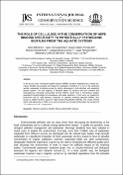Options
The role of cellulose in the conservation of HDPE binding specificity to potentially pathogenic biofilms from the aquatic systems
Date issued
2021-03
Author(s)
Abstract
In the last 20 years, moving bed biofilm reactor (MBBR) has been established as a simple yet robust, flexible, and compact technology for wastewater treatment. It is one of the advanced aerobic wastewater treatment processes by taking advantage of both attached and suspended growth systems. The vast majority of bacteria adhere to surfaces and form complex and heterogeneous microbial communities termed biofilms which have tremendous positive potential in biotechnology for biocatalysis and waste treatment. In this work, we studied the
Escherichia coli (E. coli) adhesion properties on synthetic artificial materials (SAMs), also known as biofilm carriers, based on High-Density Polyethylene (HDPE). The results showed that E. coli adherence to SAMs is not only preserved but is also enhanced by the presence of 7% cellulose in SAM’s composition.
Escherichia coli (E. coli) adhesion properties on synthetic artificial materials (SAMs), also known as biofilm carriers, based on High-Density Polyethylene (HDPE). The results showed that E. coli adherence to SAMs is not only preserved but is also enhanced by the presence of 7% cellulose in SAM’s composition.
Files
Loading...
Name
IJCS-21-23_Banciu.pdf
Description
Article
Size
316.2 KB
Format
Adobe PDF
Checksum
(MD5):8aaca032867d01cd3b65103d6371d103